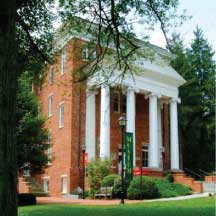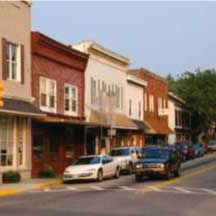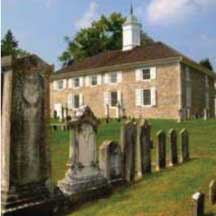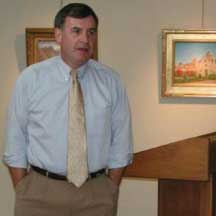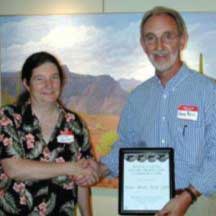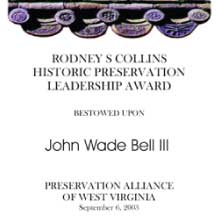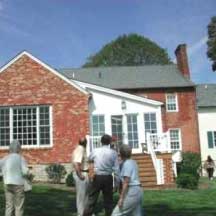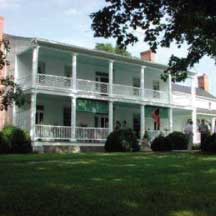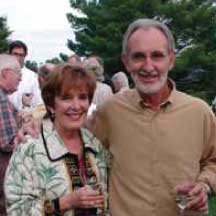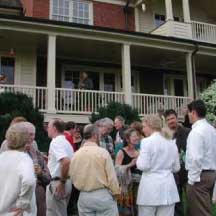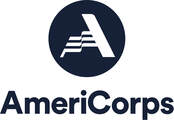2003 Conference
Preservation Successes
Post-Conference Report
PAWV Annual Conference Hailed
By Dan Gooding, PAWV Vice-President, Lewisburg
The 2003 PAWV Annual Conference, this year showcasing “Preservation Successes” in one of our state’s premiere historic towns was hailed by all who attended.
The affair began with a welcoming reception in the luxurious lobby of the Greenbrier Valley Theatre. The Greenbrier’s private reserve, private label wines were poured compliments of the resort, the flagship of West Virginia tourism. Adding to evening’s appeal, Robert S. Conte, Ph. D., the resort’s curator and historian provided a captivating pictorial review narrative of The Greenbrier’s architectural history. The Lewisburg Preservation and Enhancement Alliance, The Greenbrier, and The Greenbrier Clinic sponsored the event.
Friday and Saturday, September 5 and 6, were busy days for conference attendees who were visiting from all parts of the state. Conference registrants’ home-counties ranged from Mercer to Jefferson and from Ohio to Monroe.
Topics for the classroom style presentations, which were held at Lewisburg’s Carnegie Hall, were carefully selected to permit participants to delve deeply into the means by which the preservation successes examined have been attained. Sessions included: saving an endangered building; planning for adaptive reuse; locating resources; case studies of successful projects in Lewisburg, Huntington and Clarksburg; legislative methods; building and maintaining advocacy organizations and the Lewisburg story---a case study in turning a failed town around through Historic Preservation and Heritage Tourism. Site tours of two of Lewisburg meticulous restorations were extremely popular. Groups visited Montwell, site of Friday night’s reception and the Tyree-Dunn House, the latter a “save” of an 1805 house vacant and declining for over twenty years. In both cases the contractors were on hand to explain just what was involved in the projects.
Earlier, on Friday evening, Montwell, (1818) was opened to PAWV for a private reception and tour. Montwell is one of the city’s most important historic structures and stands on a promontory overlooking the downtown. It possesses a most distinguished countenance in the early classical revival style, featuring a double-porched portico fronted by thick, thirty-foot tall columns. Crossing the threshold under a massive fanlight, guests were treated to tours of the home which was so newly restored that no furniture was yet in place to obstruct an examination of its architecture. The Greenbrier again provided excellent wines, while The Lewisburg Preservation and Enhancement Alliance supplied the food.
The highlight of the conference was the rousing luncheon keynote speech by John Avoli, mayor of Staunton, Virginia. Avoli, a Weirton native who transplanted to Virginia to attend college in Richmond, is one of the nation’s most successful mayors in the area of economic development through Heritage Tourism. A strong advocate of Historic Preservation, Mayor Avoli spearheaded the renaissance of Staunton. He is now in his fifteenth year as mayor of the city and is recognized nationally for shepherding Staunton into a new era of national acclaim for its meticulously restored and elegant historic downtown.
As he told conference attendees of the evolution of Staunton’s recent progress, he stressed that the same could be done in most West Virginia cities piggybacking on the state’s already growing tourism industry.
Also at the luncheon, Lewisburg native and prominent businessman, John Wade Bell, was selected to receive this year’s Rodney Collins Preservation Leadership Award. Selection of John by the Board of Directors for this honor at its summer meeting in Wheeling had been an easy process in light of his extraordinary commitment to preserving and reusing historic structures in West Virginia. Most of his personal “preservation successes” have occurred in Greenbrier County, although his most recent save is of a notable log home near Wytheville, Virginia. This will be the third important log home in the path of destructive progress that he has saved by relocating it to family acreage near Lewisburg. His offices are in the restored 1805 Tyree-Dunn House the Lewisburg landmark which was included in the Saturday’s how-to-do it site tours along with Montwell. John Wade Bell recently purchased The West Virginia Hotel building near the entrance of The Greenbrier in White Sulphur Springs. The long vacant and endangered structure is about receive a careful restoration and an adaptive reuse in the exemplary style of John Wade Bell.
The weather was top-down perfect for Saturday afternoon’s tours of two of the area’s most outstanding historic homes. Spring Valley and Valley View were both visited by large caravans of conference attendees.
Both homes are still the seat of farming operations and remarkably both remain in the hands of descendents of the homesteading pioneer families that first owned them two centuries ago.
The homes are very different in design and materials and the contrast was quite interesting to attendees. The homes are quite large, splendidly decorated and carefully restored.
Lovingly preserved mementos of the pioneering Tuckwiller and Dickson families were displayed and many original family furnishings were to be seen. The bucolic settings of each of the two monumental homes made the visits seem like a scene from a Currier and Ives print.
An already perfect Saturday concluded with a wonderful picnic on the lawn of Deerfield, the mountain top residence of John Wade and Ann Bell near Lewisburg. Deerfield is a recreation of a typical noble West Virginia farmhouse that might well have been built on the site about 1840. The large brick structure includes a detached guest wing which is a fully restored, 1790, two-story log home. Stunning vistas of the surrounding countryside were enjoyed from the lawn behind the house where dinner tables were arrayed for the evening. A light breeze carried the scent of delicately seasoned sea bass as well as the equally alluring music of the area’s most popular jazz combo, The Tony Hayworth Trio.
Chef Tony Juker, owner and master of the kitchen of Lewisburg’s well respected Tavern 1785, created a dinner that exceed all expectations. The evening proved to be the perfect cap to a perfect conference.
PAWV extends a very warm thank you to all those who helped make this memorable conference possible and that would include most prominently those wonderful people who graciously opened their homes to our membership and guests, Paul and Mary Lindquist of Montwell, Page Dickson of Spring Valley Farm and Richard and Ann McClung of Valley View Farm, and John and Ann Bell of Deerfield.
By Dan Gooding, PAWV Vice-President, Lewisburg
The 2003 PAWV Annual Conference, this year showcasing “Preservation Successes” in one of our state’s premiere historic towns was hailed by all who attended.
The affair began with a welcoming reception in the luxurious lobby of the Greenbrier Valley Theatre. The Greenbrier’s private reserve, private label wines were poured compliments of the resort, the flagship of West Virginia tourism. Adding to evening’s appeal, Robert S. Conte, Ph. D., the resort’s curator and historian provided a captivating pictorial review narrative of The Greenbrier’s architectural history. The Lewisburg Preservation and Enhancement Alliance, The Greenbrier, and The Greenbrier Clinic sponsored the event.
Friday and Saturday, September 5 and 6, were busy days for conference attendees who were visiting from all parts of the state. Conference registrants’ home-counties ranged from Mercer to Jefferson and from Ohio to Monroe.
Topics for the classroom style presentations, which were held at Lewisburg’s Carnegie Hall, were carefully selected to permit participants to delve deeply into the means by which the preservation successes examined have been attained. Sessions included: saving an endangered building; planning for adaptive reuse; locating resources; case studies of successful projects in Lewisburg, Huntington and Clarksburg; legislative methods; building and maintaining advocacy organizations and the Lewisburg story---a case study in turning a failed town around through Historic Preservation and Heritage Tourism. Site tours of two of Lewisburg meticulous restorations were extremely popular. Groups visited Montwell, site of Friday night’s reception and the Tyree-Dunn House, the latter a “save” of an 1805 house vacant and declining for over twenty years. In both cases the contractors were on hand to explain just what was involved in the projects.
Earlier, on Friday evening, Montwell, (1818) was opened to PAWV for a private reception and tour. Montwell is one of the city’s most important historic structures and stands on a promontory overlooking the downtown. It possesses a most distinguished countenance in the early classical revival style, featuring a double-porched portico fronted by thick, thirty-foot tall columns. Crossing the threshold under a massive fanlight, guests were treated to tours of the home which was so newly restored that no furniture was yet in place to obstruct an examination of its architecture. The Greenbrier again provided excellent wines, while The Lewisburg Preservation and Enhancement Alliance supplied the food.
The highlight of the conference was the rousing luncheon keynote speech by John Avoli, mayor of Staunton, Virginia. Avoli, a Weirton native who transplanted to Virginia to attend college in Richmond, is one of the nation’s most successful mayors in the area of economic development through Heritage Tourism. A strong advocate of Historic Preservation, Mayor Avoli spearheaded the renaissance of Staunton. He is now in his fifteenth year as mayor of the city and is recognized nationally for shepherding Staunton into a new era of national acclaim for its meticulously restored and elegant historic downtown.
As he told conference attendees of the evolution of Staunton’s recent progress, he stressed that the same could be done in most West Virginia cities piggybacking on the state’s already growing tourism industry.
Also at the luncheon, Lewisburg native and prominent businessman, John Wade Bell, was selected to receive this year’s Rodney Collins Preservation Leadership Award. Selection of John by the Board of Directors for this honor at its summer meeting in Wheeling had been an easy process in light of his extraordinary commitment to preserving and reusing historic structures in West Virginia. Most of his personal “preservation successes” have occurred in Greenbrier County, although his most recent save is of a notable log home near Wytheville, Virginia. This will be the third important log home in the path of destructive progress that he has saved by relocating it to family acreage near Lewisburg. His offices are in the restored 1805 Tyree-Dunn House the Lewisburg landmark which was included in the Saturday’s how-to-do it site tours along with Montwell. John Wade Bell recently purchased The West Virginia Hotel building near the entrance of The Greenbrier in White Sulphur Springs. The long vacant and endangered structure is about receive a careful restoration and an adaptive reuse in the exemplary style of John Wade Bell.
The weather was top-down perfect for Saturday afternoon’s tours of two of the area’s most outstanding historic homes. Spring Valley and Valley View were both visited by large caravans of conference attendees.
Both homes are still the seat of farming operations and remarkably both remain in the hands of descendents of the homesteading pioneer families that first owned them two centuries ago.
The homes are very different in design and materials and the contrast was quite interesting to attendees. The homes are quite large, splendidly decorated and carefully restored.
Lovingly preserved mementos of the pioneering Tuckwiller and Dickson families were displayed and many original family furnishings were to be seen. The bucolic settings of each of the two monumental homes made the visits seem like a scene from a Currier and Ives print.
An already perfect Saturday concluded with a wonderful picnic on the lawn of Deerfield, the mountain top residence of John Wade and Ann Bell near Lewisburg. Deerfield is a recreation of a typical noble West Virginia farmhouse that might well have been built on the site about 1840. The large brick structure includes a detached guest wing which is a fully restored, 1790, two-story log home. Stunning vistas of the surrounding countryside were enjoyed from the lawn behind the house where dinner tables were arrayed for the evening. A light breeze carried the scent of delicately seasoned sea bass as well as the equally alluring music of the area’s most popular jazz combo, The Tony Hayworth Trio.
Chef Tony Juker, owner and master of the kitchen of Lewisburg’s well respected Tavern 1785, created a dinner that exceed all expectations. The evening proved to be the perfect cap to a perfect conference.
PAWV extends a very warm thank you to all those who helped make this memorable conference possible and that would include most prominently those wonderful people who graciously opened their homes to our membership and guests, Paul and Mary Lindquist of Montwell, Page Dickson of Spring Valley Farm and Richard and Ann McClung of Valley View Farm, and John and Ann Bell of Deerfield.
Schedule of Events
(Please note that some details may still be subject to change -- check back here for updates, if any.)
DAY ONE
Thursday, September 4 - Greenbrier Valley Theater
5:15 pm Welcome Reception , Sponsored by Lewisburg Preservation Alliance
6:00 pm Dr. Robert S. Conte, PhD, Curator and Historian of The Greenbrier.
"The Greenbrier's use of historic preservation and its architectural assets."
DAY TWO
Friday, September 5 - 9:00 am - Carnegie Hall Front Entrance
Lewisburg Walking Tour - Guided Tour. The highlights will include the outstanding John North House (1820), The Old Stone Church (1780) and its cemetery, and West Virginia's Carnegie Hall (1900)
Registration _ 11 am to 5 pm - Carnegie Hall
Lunch - on your own at any of Lewisburg's excellent downtown restaurants
Session One _ 1 pm to 2:30 pm
Successful projects and how you can do it too — Including how to save an endangered building, planning for adaptive reuse, where to find help and resources
OR
Lewisburg — A case study of turning around an economically challanged town through historic preservation and heritage tourism
Session Two — 2:45 pm to 4:15 pm
Successful projects start to finish— Before and after slides/discussion of some successful projects, including some of the Lewisburg area examples that are seen during conference tours
OR
What a community can do. Including historic districts, design review options, and Landmarks Commissions
Reception & tours at Montwell 4:30 - 6:30pm
Get a rare glimpse at a just completed, meticulously restored 1818 Lewisburg home. Refreshments provided by
The Greenbrier.
Dinner - on your own at any of the city's excellent restaurants
DAY THREE
Saturday, September 6 - 8:00 am - Carnegie Hall
Registration and coffee
Session Three 8:45 am to 10:15 am
Preservation non-profits — How to build an active & successful membership organization, examining Lewisburg Preservation Alliance and Lewisburg Foundation as models.
Session Four 10:30 am to 12:00 noon
Advocacy and education _ How to work with governments and the public on all levels from local to national.
OR
Tour Session — 8:45 am to 12:00 noon
Saving a building from scratch — Discussion then tour of two examples of buildings snatched from the wrecking ball to successful rehabilitation. Includes a 1805 stone and brick house now used as business offices, and a 1880 board and batten frame dwelling restored to a comfortable residence.
Luncheon, Annual Meeting & Keynote Speaker — 12:15 - 2:00
Saturday Afternoon Tour — 2:30 to 5:30
Tour one of the Greenbrier Valley's most interesting and architecturally distinctive homes, Spring Valley. Also tour the town of Union and visit to Salt Sulphur Springs, one of the few surviving springs resorts of the nineteenth century.
OR
Shopping on own in historic Lewisburg
Saturday Evening Party — 6:30 - 9:30
Garden Party at Deerfield, the stunning residence of Mr. & Mrs. John Wade Bell, III. Enjoy the spectacular view of the Greenbrier River Canyon. Bar-B-Q cookout dinner with live music by one of the areas most popular jazz ensembles.
DAY ONE
Thursday, September 4 - Greenbrier Valley Theater
5:15 pm Welcome Reception , Sponsored by Lewisburg Preservation Alliance
6:00 pm Dr. Robert S. Conte, PhD, Curator and Historian of The Greenbrier.
"The Greenbrier's use of historic preservation and its architectural assets."
DAY TWO
Friday, September 5 - 9:00 am - Carnegie Hall Front Entrance
Lewisburg Walking Tour - Guided Tour. The highlights will include the outstanding John North House (1820), The Old Stone Church (1780) and its cemetery, and West Virginia's Carnegie Hall (1900)
Registration _ 11 am to 5 pm - Carnegie Hall
Lunch - on your own at any of Lewisburg's excellent downtown restaurants
Session One _ 1 pm to 2:30 pm
Successful projects and how you can do it too — Including how to save an endangered building, planning for adaptive reuse, where to find help and resources
OR
Lewisburg — A case study of turning around an economically challanged town through historic preservation and heritage tourism
Session Two — 2:45 pm to 4:15 pm
Successful projects start to finish— Before and after slides/discussion of some successful projects, including some of the Lewisburg area examples that are seen during conference tours
OR
What a community can do. Including historic districts, design review options, and Landmarks Commissions
Reception & tours at Montwell 4:30 - 6:30pm
Get a rare glimpse at a just completed, meticulously restored 1818 Lewisburg home. Refreshments provided by
The Greenbrier.
Dinner - on your own at any of the city's excellent restaurants
DAY THREE
Saturday, September 6 - 8:00 am - Carnegie Hall
Registration and coffee
Session Three 8:45 am to 10:15 am
Preservation non-profits — How to build an active & successful membership organization, examining Lewisburg Preservation Alliance and Lewisburg Foundation as models.
Session Four 10:30 am to 12:00 noon
Advocacy and education _ How to work with governments and the public on all levels from local to national.
OR
Tour Session — 8:45 am to 12:00 noon
Saving a building from scratch — Discussion then tour of two examples of buildings snatched from the wrecking ball to successful rehabilitation. Includes a 1805 stone and brick house now used as business offices, and a 1880 board and batten frame dwelling restored to a comfortable residence.
Luncheon, Annual Meeting & Keynote Speaker — 12:15 - 2:00
Saturday Afternoon Tour — 2:30 to 5:30
Tour one of the Greenbrier Valley's most interesting and architecturally distinctive homes, Spring Valley. Also tour the town of Union and visit to Salt Sulphur Springs, one of the few surviving springs resorts of the nineteenth century.
OR
Shopping on own in historic Lewisburg
Saturday Evening Party — 6:30 - 9:30
Garden Party at Deerfield, the stunning residence of Mr. & Mrs. John Wade Bell, III. Enjoy the spectacular view of the Greenbrier River Canyon. Bar-B-Q cookout dinner with live music by one of the areas most popular jazz ensembles.
Conference Details
September 4, 5, & 6, 2003 - Lewisburg, West Virginia
Presented In Partnership with Lewisburg Preservation and Enhancement Alliance, Inc. and the West Virginia State Historic Preservation Office (Division of Culture and History)
West Virginia Historic Preservation Accentuates the Positive
Join us in Lewisburg for a conference rich in the stories of achievement in preservation and organization building. The conference will feature timely topics, examining Lewisburg as a case study of economic improvement through heritage and cultural tourism. Leading the team of experts will be this year's Keynote Speaker, the Honorable G. John Avoli, Mayor, Staunton, VA. During Mayor Avoli's 14 years in office, Staunton has received numerous national awards for its exemplary pursuit of historic preservation and the arts in economic development. This has been the root of its economic and quality of life successes, which are based on tourism. Happily, the results have exceeded the city's leaders' expectations. Mayor Avoli is a native of northern West Virginia who has resided in Virginia since completing his education.
Conference Host Community - LEWISBURG
Economic Development based on Heritage and Cultural Tourism was a key factor in bringing Lewisburg back to life. It has propelled the community to a level no one dreamed of when it all began in the early 1980's. National Geographic included a glowing chapter on Lewisburg in its recent book on the 75 best small town visits in the nation. The 1999 best selling guide The 100 Best Small Arts Towns in America carved out a chapter full of praise for the city's achievements as well.
Why has Lewisburg received this recognition and how has it maintained its vibrant downtown commerce? Answers to these questions are part of this year's conference, which is a must for West Virginians interested in seeing their communities move forward. Lewisburg's leaders believe that the single best economic development possibility available to a West Virginia town is tourism based on historic preservation and cultural allure.
Speakers and Panel Members Include:
John Avoli -- Mayor, Staunton, Virginia - KEYNOTE SPEAKER
Chris Knorr -- WV State Historic Preservation Office - Structural Historian and CLG Coordinator
Rob Nieweg -- Director Southern Field Office, National Trust for Historic Preservation
Brandon Johnson, Esq. -- Chair, Lewisburg Historic Landmarks Commission
Dan Gooding, CFP -- Commissioner, Lewisburg Landmarks Commission; and President, Lewisburg Preservation Alliance
TAG Galyen, AIA - President, TAG Architectural Studio; Adjunct Faculty, Harvard University
Phil Gainer -- Past Mayor, Lewisburg - Property Developer
John Manchester - Current Mayor, Lewisburg - PR Executive
R.B. "Duke" Fouch -- Past Mayor, Lewisburg -- Retired GE Executive
Mike Gioulis -- Preservation Architectural and Design Consultant
John Wade Bell, III -- Developer and Preservation Contractor
Lodging
The historic General Lewis Inn near downtown Lewisburg has reserved a block of rooms for the PAWV conference until August 15. Call 645-2600 to reserve. For other lodging, Greenbrier County offers a wide variety of quality lodging from name brand motels to charming B&Bs to the elegant Greenbrier Resort. Go to www.greenbrierwv.com or call 800.833.2068 for more information.
Fees and Registration
Limited Conference Activities Member Rates (Non-Member)
Student Rates are available -- contact the addresses below for details.
Please pre-register by August 29 -- Meals not guaranteed if not pre-registered.
Registrations should be sent to:
PAWV
PO Box 3371
Charleston, WV 25333
You can e-mail your preregistration to <[email protected]> as well, although a check will still need to be mailed USPS. (As we don't have the means to process credit cards.) Particularly for late registrations (within the last week or so before event) be sure to e-mail us, in case the mail doesn't arrive in time.
Partners, Sponsors and Friends of the Conference
PAWV thanks the many partners who are helping to make this conference possible, including National Trust for Historic Preservation; Lewisburg Preservation Alliance; Greenbrier County Convention and Visitors Bureau; The Greenbrier; Carnegie Hall of WV, Inc.; Deerfield _ Mr. and Mrs. John Wade Bell, III; Spring Valley Farm - Paige Dixon; Montwell - Paul and Mary Lindquist; The Walkabout Company; and many other contributors and volunteers.
Presented In Partnership with Lewisburg Preservation and Enhancement Alliance, Inc. and the West Virginia State Historic Preservation Office (Division of Culture and History)
West Virginia Historic Preservation Accentuates the Positive
Join us in Lewisburg for a conference rich in the stories of achievement in preservation and organization building. The conference will feature timely topics, examining Lewisburg as a case study of economic improvement through heritage and cultural tourism. Leading the team of experts will be this year's Keynote Speaker, the Honorable G. John Avoli, Mayor, Staunton, VA. During Mayor Avoli's 14 years in office, Staunton has received numerous national awards for its exemplary pursuit of historic preservation and the arts in economic development. This has been the root of its economic and quality of life successes, which are based on tourism. Happily, the results have exceeded the city's leaders' expectations. Mayor Avoli is a native of northern West Virginia who has resided in Virginia since completing his education.
Conference Host Community - LEWISBURG
Economic Development based on Heritage and Cultural Tourism was a key factor in bringing Lewisburg back to life. It has propelled the community to a level no one dreamed of when it all began in the early 1980's. National Geographic included a glowing chapter on Lewisburg in its recent book on the 75 best small town visits in the nation. The 1999 best selling guide The 100 Best Small Arts Towns in America carved out a chapter full of praise for the city's achievements as well.
Why has Lewisburg received this recognition and how has it maintained its vibrant downtown commerce? Answers to these questions are part of this year's conference, which is a must for West Virginians interested in seeing their communities move forward. Lewisburg's leaders believe that the single best economic development possibility available to a West Virginia town is tourism based on historic preservation and cultural allure.
Speakers and Panel Members Include:
John Avoli -- Mayor, Staunton, Virginia - KEYNOTE SPEAKER
Chris Knorr -- WV State Historic Preservation Office - Structural Historian and CLG Coordinator
Rob Nieweg -- Director Southern Field Office, National Trust for Historic Preservation
Brandon Johnson, Esq. -- Chair, Lewisburg Historic Landmarks Commission
Dan Gooding, CFP -- Commissioner, Lewisburg Landmarks Commission; and President, Lewisburg Preservation Alliance
TAG Galyen, AIA - President, TAG Architectural Studio; Adjunct Faculty, Harvard University
Phil Gainer -- Past Mayor, Lewisburg - Property Developer
John Manchester - Current Mayor, Lewisburg - PR Executive
R.B. "Duke" Fouch -- Past Mayor, Lewisburg -- Retired GE Executive
Mike Gioulis -- Preservation Architectural and Design Consultant
John Wade Bell, III -- Developer and Preservation Contractor
Lodging
The historic General Lewis Inn near downtown Lewisburg has reserved a block of rooms for the PAWV conference until August 15. Call 645-2600 to reserve. For other lodging, Greenbrier County offers a wide variety of quality lodging from name brand motels to charming B&Bs to the elegant Greenbrier Resort. Go to www.greenbrierwv.com or call 800.833.2068 for more information.
Fees and Registration
- Full Conference Participation (As a Member of the PAWV) $75
- Full Conference Participation (Non-member) $90 (includes PAWV membership for remainder of 2003)
Limited Conference Activities Member Rates (Non-Member)
- Friday only $40 ($45)
- Saturday morning & luncheon $40 ($45)
- Saturday afternoon tour $15 ($20)
- Saturday evening dinner party $15 ($20)
Student Rates are available -- contact the addresses below for details.
Please pre-register by August 29 -- Meals not guaranteed if not pre-registered.
Registrations should be sent to:
PAWV
PO Box 3371
Charleston, WV 25333
You can e-mail your preregistration to <[email protected]> as well, although a check will still need to be mailed USPS. (As we don't have the means to process credit cards.) Particularly for late registrations (within the last week or so before event) be sure to e-mail us, in case the mail doesn't arrive in time.
Partners, Sponsors and Friends of the Conference
PAWV thanks the many partners who are helping to make this conference possible, including National Trust for Historic Preservation; Lewisburg Preservation Alliance; Greenbrier County Convention and Visitors Bureau; The Greenbrier; Carnegie Hall of WV, Inc.; Deerfield _ Mr. and Mrs. John Wade Bell, III; Spring Valley Farm - Paige Dixon; Montwell - Paul and Mary Lindquist; The Walkabout Company; and many other contributors and volunteers.
This conference of Preservation Alliance of West Virginia, is co-sponsored by the WV State Historic Preservation Office (with partial funding by the WV Division of Culture and History and the National Park Service), The project that was the purpose of this activity has been financed in part with Federal funds from the National Park Service, Department of the Interior, and administered by the West Virginia Division of Culture and History. However, the contents and opinions do not necessarily reflect the views or policies of the Department of the Interior, nor does the mention of trade names or commercial products constitute endorsement or recommendations by the Department of the Interior. Regulations of the U.S. Department of the Interior strictly prohibit unlawful discrimination in departmental Federally Assisted Programs on the basis of race, color, national origin, age or handicap. Any person who believes he or she has been discriminated against in any program, activity, or facility operated by a recipient of Federal assistance should write to: Director, Equal Opportunity Program, U.S. Department of the Interior, National Park Service, 1849 C Street, Washington, D.C. 20240

